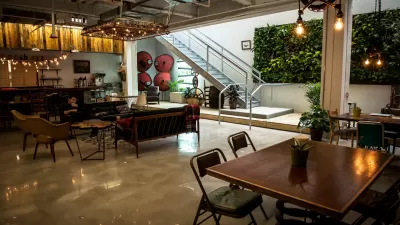The communal living opportunity for San Jose residents was made possible by the creation of an entirely new designation in the city's zoning code.

Sarah Holder reports on the biggest project yet from developer Starcity, an 18-story building with 803 units in Downtown San Jose, California. The catch: Starcity develops buildings for co-living arrangements, already completing seven projects in Los Angeles and San Francisco.
"In most Starcity buildings, renters get a furnished 130- to 220-square-foot bedroom and share a communal kitchen and living space," writes Holder. "In a [sic] addition to a “generous bathroom to room ratio,” the company touts a range of Millennial-friendly amenities, including an honor library, 'locally sourced foliage,' and Bob Ross painting nights. Rents range from $1,400 to $2,400 a month."
According to Holder, the development proposed for San Jose would be the world's largest co-living building in the world.
Holder parlays the discussion about the new Starcity project to discussions about Starcity's many contemporaries trying to make the old model of single-room occupancy hotels (SROs) new for the 21st century.
Starcity considers itself distinct from SROs, however, in how it uses each building, as Curbed SF reported: "95 percent of the usable square footage in an SRO is renters’ rooms, with the remaining five percent mostly hallways. By comparison, a Starcity building is about 65 percent bedrooms, and 20 percent of the building is dedicated to ‘communal spaces and kitchens.’” And renters commit to living there longer than the transient characters who once bunked at week-to-week boarding houses…
As noted by Holder, the new model for communal living also breaks the mold of most zoning codes, including in San Jose. Starcity had to work with the city to create an entirely new form of land use: "co-living." While Starcity's previous developments used zoning classifications already in existence in those cities, the San Jose experience offered a chance to be the first-ever use of the co-living zoning classification, according to Holder.
FULL STORY: The Largest Co-Living Building in the World Is Coming to San Jose

Alabama: Trump Terminates Settlements for Black Communities Harmed By Raw Sewage
Trump deemed the landmark civil rights agreement “illegal DEI and environmental justice policy.”

Study: Maui’s Plan to Convert Vacation Rentals to Long-Term Housing Could Cause Nearly $1 Billion Economic Loss
The plan would reduce visitor accommodation by 25% resulting in 1,900 jobs lost.

Why Should We Subsidize Public Transportation?
Many public transit agencies face financial stress due to rising costs, declining fare revenue, and declining subsidies. Transit advocates must provide a strong business case for increasing public transit funding.

Wind Energy on the Rise Despite Federal Policy Reversal
The Trump administration is revoking federal support for renewable energy, but demand for new projects continues unabated.

Passengers Flock to Caltrain After Electrification
The new electric trains are running faster and more reliably, leading to strong ridership growth on the Bay Area rail system.

Texas Churches Rally Behind ‘Yes in God’s Back Yard’ Legislation
Religious leaders want the state to reduce zoning regulations to streamline leasing church-owned land to housing developers.
Urban Design for Planners 1: Software Tools
This six-course series explores essential urban design concepts using open source software and equips planners with the tools they need to participate fully in the urban design process.
Planning for Universal Design
Learn the tools for implementing Universal Design in planning regulations.
Caltrans
Smith Gee Studio
Institute for Housing and Urban Development Studies (IHS)
City of Grandview
Harvard GSD Executive Education
Toledo-Lucas County Plan Commissions
Salt Lake City
NYU Wagner Graduate School of Public Service





























